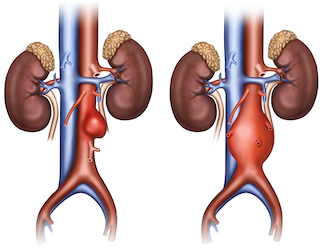Aortic Aneurysm
The largest artery in the body is the aorta which transports blood to various organs of the body.
Aorta originates from the left ventricle of the heart and aortic valve and arches in the upper chest and follows down into the abdomen and pelvis close to the spine. Branches of the aorta supply blood to the various organs of the body including the head, the arms, the intestines, the kidneys, the liver and the legs.
An aortic aneurysm is an enlargement of the aorta at the various levels which can be seen as a dilatation or bulging on diagnostic studies.
If the aneurysm enlarges, it would stretch the various walls of the aorta making them susceptible to rupture. A ruptured aneurysm is serious condition that can lead to death in a short period of time.


Aortic aneurysm can occur in various part of the body:
- Thoracic aortic aneurysm are in the chest
- Thoracoabdominal aneurysms extending from the chest into the abdomen
- Abdominal aortic aneurysms are within the abdominal cavity and can extend into the arteries of the thighs
- Aortic aneurysms are very serious medical conditions and carry a high risk of Aortic aneurysms are very serious medical conditions and carry a high risk of
Certain disorders increase the risk of developing aortic aneurysms which include:
- Emphysema
- Atherosclerotic heart disease
- Inherited disease such as Marfan syndrome or Ellers syndrome
- Smoking
- COPD
Symptoms of aortic aneurysm
In general, most people with small aortic aneurysms do not have any symptoms however as the aneurysm enlarges it can put pressure on the nearby structures with various symptoms these include
- Emphysema
- Atherosclerotic heart disease
- Inherited disease such as Marfan syndrome or Ellers syndrome
- Smoking
- COPD
If aneurysm ruptures, it can cause severe chest pain back pain followed by internal bleeding which would cause fainting sweating rapid heart rate weakness and death very rapidly.
Diagnosis of aortic aneurysms
It is difficult to diagnose aortic aneurysms on physical examination however noninvasive studies such as ultrasound or very good at diagnosing aortic aneurysms quickly and reliably. The common diagnostic test for aortic aneurysms are:
- Ultrasound
- CT angiogram
- Magnetic resonance angiography, MRA
Treatments of aortic aneurysm
Aortic aneurysms should be treated if they enlarge to a certain size or if there is a high rate of enlargement but certain risk factors. Treatment should also come in earlier if there is a family history of ruptured aortic aneurysm or connective tissue disorder.
We follow patients in our aneurysm clinic with regularly with ultrasounds and other diagnostic
studies and monitor the size of the aneurysm and the rate of the increasing the size. Medical therapy is instituted in every patient with tight blood pressure control, diabetes control and smoking cessation however if patient’s meet criteria, surgical therapy would be indicated.
Abdominal aortic aneurysm repair
This is a well-established procedure which dates back at least 50 years It is a invasive procedure where the thoracic or abdominal cavity is entered. it requires general anesthesia. the part of the aorta which is aneurysmal is resected and changed with an artificial tube graft.
This procedure takes about 2-4 hours and patient’s stay in the hospital for about a week. Recovery time is several weeks to months.
Minimally invasive procedures
Endovascular aortic repair EVAR is relatively new however is much better tolerated than open surgery because of its minimal invasiveness.
During this procedure, the an Endo graft is placed inside the aneurysm which obliterates the aneurysm and decreases the chance of rupture.
This procedure can be done with needle holes in the femoral arteries in the groin.
This procedure is done under regional or general anesthesia he can also be done under local anesthesia with fluoroscopy and it usually takes one to 2 almost a complete.
Recoveries quick and patients usually go home the next day.
At Encino Vascular Institute & vein center we can diagnose aortic aneurysms with ultrasounds or angiograms and provide recommendations for treatments
Proudly accepting patients in